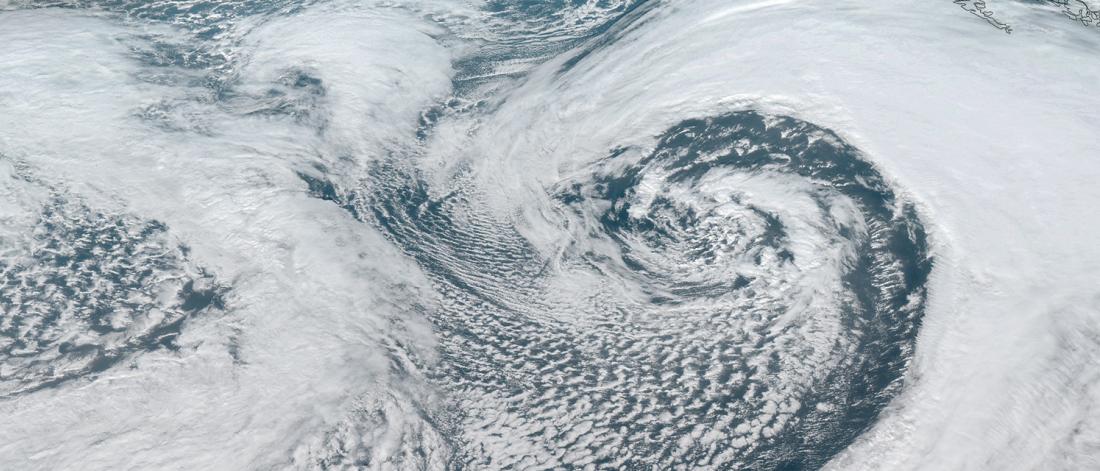Dr. Alex Crawford
Project Lead
Dr. Julienne Stroeve
Collaborator
Dr. Michelle McCrystall
External Collaborator
Dr. Armina Soleymani
Post-doctoral fellow
The University of Manitoba campuses and research spaces are located on original lands of Anishinaabeg, Ininiwak, Anisininewuk, Dakota Oyate, Dene and Inuit, and on the National Homeland of the Red River Métis. More
University of Manitoba
Winnipeg, Manitoba Canada, R3T 2N2

Extratropical cyclones (i.e., large storm systems) are integral aspects of the Canadian and Arctic climate systems, transporting energy and moisture from lower latitudes, driving sea ice motion and ocean currents, and causing rapid changes to wind and temperature. The high winds, low visibility, and heavy precipitation that accompany some storms can also present major hazards to infrastructure and human activities and act as disturbances to ecosystems. The focus of this program is to better understand the origins, development, and impacts of these storms in Canada and the Arctic, their interrelationships with other aspects of the climate system, and how these storms and their relationships may change in a warming world. We use a variety of research tools, especially atmospheric reanalysis, climate models, and the CEOS/NSIDC Extratropical Cyclone Tracking (CNECT) algorithm.
Dr. Alex Crawford
Project Lead
Dr. Julienne Stroeve
Collaborator
Dr. Michelle McCrystall
External Collaborator
Dr. Armina Soleymani
Post-doctoral fellow
Dr. Mark Serreze
External Collaborator
Ana Cláudia Cardoso de Jesus
Master's Student
Wenwei Zhu
Master's Student
The University of Manitoba’s 2024-2029 Strategic Plan highlights addressing the impacts of climate change as a major part of building a sustainable future. The impacts of climate change are often felt via changes in the frequency, intensity, and duration of weather events like storms – including extreme events like blizzards and flood-inducing heavy rains. Better understanding of how large-scale storms form, develop, and interact with the rest of the climate system will help us better project how such storms will impact us in the future. The publications, datasets, and outreach materials generated by this project, such as those listed below, help advance that understanding.
Researchers
Peer-Reviewed Publications
A decomposition of the key drivers of current and future Northern Hemisphere cyclone-associated precipitation trends.
Crawford A, N Loeb, & M McCrystall (2025). A decomposition of the key drivers of current and future Northern Hemisphere cyclone-associated precipitation trends. Journal of Climate, 38(13), 3075-3092, https://doi.org/10.1175/JCLI-D-24-0453.1
Projections and physical drivers of extreme precipitation in Greenland & Baffin Bay.
Loeb, N, A Crawford, A Herrington, M McCrystall, J Stroeve, & J Haneisak (2024). Projections and physical drivers of extreme precipitation in Greenland & Baffin Bay. Journal of Geophysical Research: Atmospheres, 129, e2024JD041375. https://doi.org/10.1029/2024JD041375.
Extreme Arctic weather and community impacts in Nunavut: A case study of one winter's storms and lessons for local climate change preparedness.
Fox S, A Crawford, M McCrystall, J Stroeve, J Lukovich, N Loeb, J Natanine, & M Serreze (2023). Extreme Arctic weather and community impacts in Nunavut: A case study of one winter’s storms and lessons for local climate change preparedness. Weather, Climate and Society, 15(4), 881-892. https://doi.org/10.1175/WCAS-D-23-0006.1.
The response of extratropical cyclone propagation in the Northern Hemisphere to global warming.
Crawford AD, MR McCrystall, JV Lukovich, & JC Stroeve (2023). The Response of extratropical cyclone propagation in the Northern Hemisphere to global warming. Journal of Climate, 36(20), 7123-7142. https://doi.org/10.1175/JCLI-D-23-0082.1.
Characteristics of extreme daily precipitation events over the Canadian Arctic.
Serreze, MC, J Voveris, AP Barrett, S Fox, PD Blanken, & A Crawford (2022). Characteristics of extreme daily precipitation events over the Canadian Arctic. International Journal of Climatology, 42(16), 10353-10372. https://doi.org/10.1002/joc.7907.
Reduced Sea Ice Enhances Intensification of Winter Storms over the Arctic Ocean.
Crawford A, J Lukovich, M McCrystall, J Stroeve, & D Barber (2022). Reduced Sea Ice Enhances Intensification of Winter Storms over the Arctic Ocean. Journal of Climate, 35(11), 3353-3370. https://doi.org/10.1175/JCLI-D-21-0747.1.
Sensitivity of Northern Hemisphere cyclone detection and tracking results to fine spatial and temporal resolution using ERA5.
Crawford, AD, EAP Schreiber, N Sommer, MC Serreze, JC Stroeve, & DG Barber (2021). Sensitivity of Northern Hemisphere cyclone detection and tracking results to fine spatial and temporal resolution using ERA5. Monthly Weather Review, 149(8), 2581–2598. https://doi.org/10.1175/mwr-d-20-0417.1.
Summer High‐Wind Events and Phytoplankton Productivity in the Arctic Ocean.
Crawford AD, KM Krumhardt, NS Lovenduski, G van Dijken, & K Arrigo (2020). Summer High‐Wind Events and Phytoplankton Productivity in the Arctic Ocean. Journal of Geophysical Research: Oceans, 125, e2020JC016565. https://doi.org/10.1029/2020JC016565.
Centre for Earth Observation Science
535 Wallace Building
125 Dysart Rd.
University of Manitoba (Fort Garry campus)
Winnipeg, MB R3T 2N2 Canada